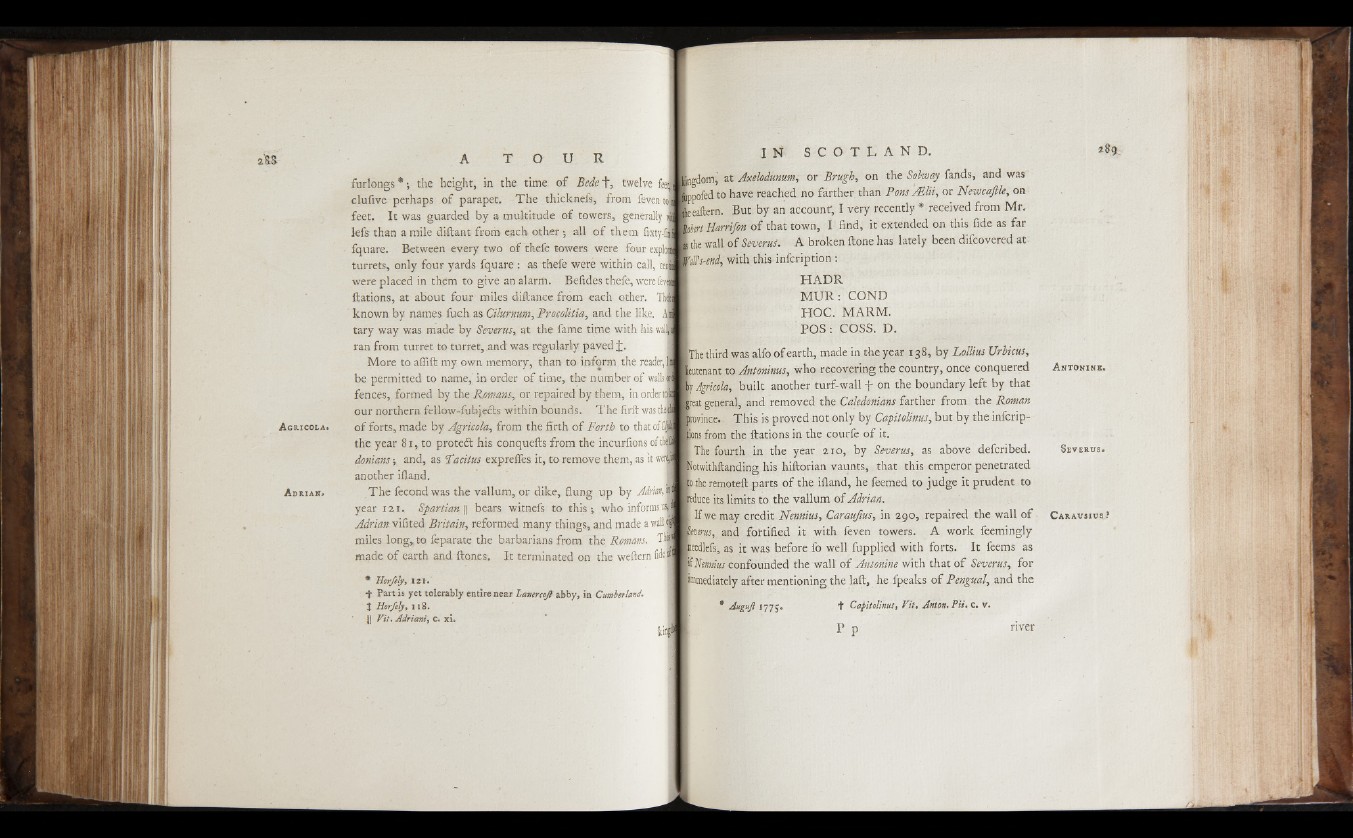
A g r ic o l a *
A d r ia n *
furlongs*; the height, in the time of Bede 1-, twelve feel
clufive perhaps of parapet. The thicknefs, from feven tol
feet. It was guarded by a multitude of towers, generally i
lefs than a mile diftant from each other ; all of them fixty-lil
fquare. Between every two of thefe towers were four explol
turrets, only four yards fquare : as thefe were within call, cer|
were placed in them to give an alarm. Befides thefe, were ij
ftations, at about four miles diftanee from each other. 1
' known by names fuch as Cilurnum, Procolitia, and the like, ifl
tary way was made by Severas, at the fame time with his wall
ran from turret to turret, and was regularly paved
More to affift my own memory, than to inform the reader, A
be permitted to name, in order of time, the number of walls A
fences, formed by the Romans, or repaired by them, in order if
our northern fellow-fubjefe within bounds. The firft was the*
of forts, made by Agrícola, from the firth of Forth to that of Cl
the year 8i, to proteit his conquefts from the incurfions oftbefi
donians; and, as Tacitus expreffes it, to remove them, as it werj
another ifland.
The fecondwas the vallum, or dike, flung up by Adrian, I
year 121. Spartian || bears witnefs to this; who informs u®
Adrian vifited Britain, reformed many things, and m a d e a wall®
miles long, to feparate the barbarians from the Romans. Th®
made of earth and ñones:. It terminated on the weftern fide 1;
* Hor/ely, l i f .
+ Part is yet tolerably entire near Lanercojt abby, in Cumberland.
J Hor/ehf, 1 18.
I) F it. Adrianit c. x i.
Ingdom, at Axelodunum, or Brugh, on the Solway fands, and was
Ippofed to have reached no farther than Pons Mlii, or Newcaftle, on
keeaftern. But by an account, I very recently * received from Mr.
Mcrt Harrifon of that town, I find, it extended on this fide as far
asthe wall of Several. A broken itone has lately been difcovered at
ftd’s-end, with this infcription ;
HADR
M U R : COND
HOC. MARM.
POS: COSS. D.
■The third was alfo of earth, made in the year 138, by Lollius Urbicus,
■eutenant to Antoninus, who recovering the country, once conquered
h Agricola, built another turf-wall f on the boundary left by that
treat general, and removed the Caledonians farther from the Roman
ftrovince. This is proved not only by Capitolinus, but by the infcrip-
ftions from the ftations in the courfe of it.
I The fourth in the year 210, by Severus, as above defcribed.
Ifotwithftanding his hiftorian vaunts, that this emperor penetrated
60 the remoteft parts of the ifland, he feemed to judge it prudent to
■educe its limits to the vallum of Adrian.
ft If we may credit Nennius, Caraufius, in 290, repaired the wall of
warns, and fortified it with feven towers. A work feemingly
■eedlefs, as it was before fo well fupplied with forts. It feems as
Nennius confounded the wall of Antonine with that of Severus, for
¡immediately after mentioning the laft, he fpeaks of Pengual, and the
# Auguji 1775« t Capitolinus, F it. Anton. Pii» c . v .
P p . river
A n t o n i n e .
S e v e r u s #
C a r a u s iu s ?